Welcome to Moda Fabrics!
I've Got A Notion - Pins & Needles
I've Got A Notion - Pins & Needles
If you sew, you use pins and needles. Let me rephrase that... if you stitch, you use pins and needles. Technically, you could assemble a fabric object using a stapler and/or glue. But it wouldn't look like this.
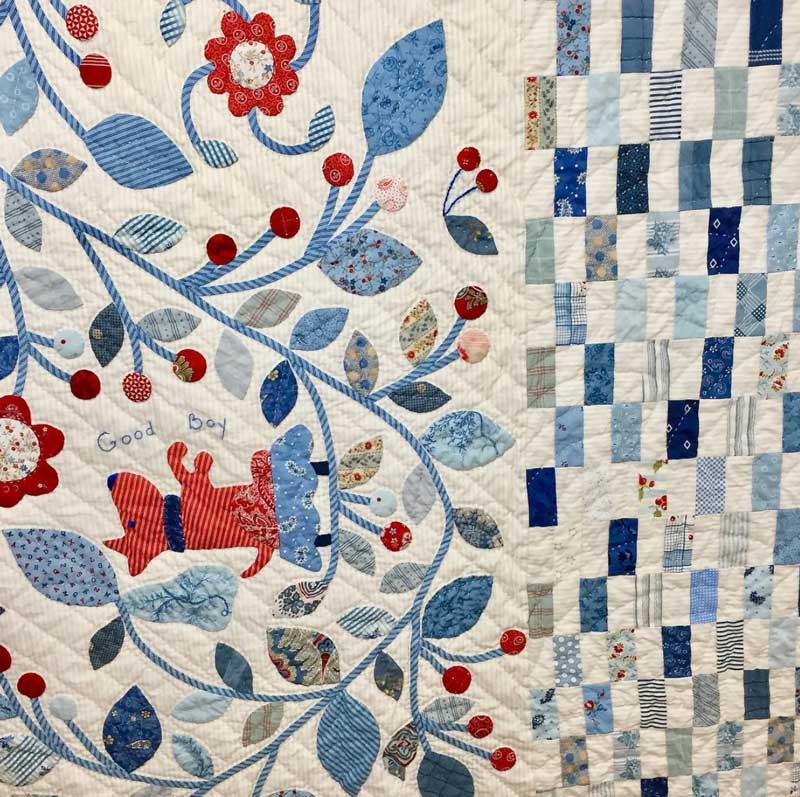
As with scissors, cutting tools and rulers, this isn't a list of "best products" or "you need to use this" so much as a list of options. Change the materials, change the tools - what works best for one thing might not be the best choice for something else.
One thing to keep in mind for pins and needles - what is the content of the metal being used? While there are several types of metal available today - stainless steel, nickel-plated steel, nickel-plated brass, brass, and chrome-plated steel, with nickel- and chrome-plated steel being the most common.
But be careful - leaving pins in fabric, exposing them to humidity, steam or the filling in some pincushions can cause the plating to break down. That results in tiny flaking, and an abrasive surface to the pin that can damage fine fabrics.
Pins.Pins will vary based on length and width - the thickness of the pin itself.
Thickness of the pin shaft. Pins are measured in millimeters - the smaller the number, the finer the pin-shaft. The finer the pin, the more bendable it can be. That's okay for some uses, not as much for others. Personal preference is also a factor - some folks don't mind that, others loathe it.
When you see a package of pins, look for the measurements as many pins will be described as "fine" on the packaging. To show how that can vary, four of these pins have "fine" on the package and the thickness of the pin shaft ranges from 0.35mm to 0.5mm.

Length. Pins can range from 1" long to more than 2" long. Appliqué pins and dressmaking pins used for silks tend to be shorter in length, while patchwork pins are generally longer. Note that while some pins might be classified by size with the size having a specific length, most manufacturers now list the actual length.
Point. There are three types of tips for pins. (And some needles.)
- Sharp - Most multi-purpose sewing pins have a sharp point that can be used for loosely-woven medium- and heavy-weight fabrics.
- Extra-sharp - These pins have a more defined and tapered point allowing them to pass easily through delicate and fine fabrics like silk, lawn and light-weight fabrics.
- Ball-point - These pins were created for sewing with knits and feature a rounded point that slips between the loops of the fabrics without piercing or pulling the yarns-threads.
If you've seen a "notions wall" at any kind of sewing-quilting shop, you already know there are a lot of choices for pins. Some are simply pretty, some are for a very specific purpose. So let's go through some of the options:
- Dressmaker or all-purpose pins. Also known as silk pins, these are fine steel needle-like pins used to hold fabrics in place before sewing. These pins can have glass or plastic heads, or a simple metal head.
- Patchwork pins. Patchwork pins and quilting pins are a bit different with patchwork pins often being shorter and finer. They are designed to hold multiple layers of fabric together for piecing, and they come primarily with glass-heads.
- Fork pins. Used to prevent the movement of fabrics while making garments and quilting projects - they can be particularly useful to quilters who press their seams open. These pins do not have a head.
- Flower-head pins. Used for quilting and sewing projects, flower-head pins come in a wide variety of lengths and thickness. Their flat heads make them easy to see. Flower-head pins have plastic heads.
- T-pins. Designed to hold down fabrics during upholstery or during those rare craft projects that do require pressing with an iron. These pins tend to be longer and thicker than sewing pins.
Glass-head versus plastic-head pins. Glass-head pins can be ironed without worrying about the head melting. That is more useful in dressmaking and garment-making, but if you frequently iron your pinned pieces, glass-head pins are a must.

Pin options. Since the idea of pinning is to hold two or more layers of fabric together before-during sewing, there are other non-pin options.
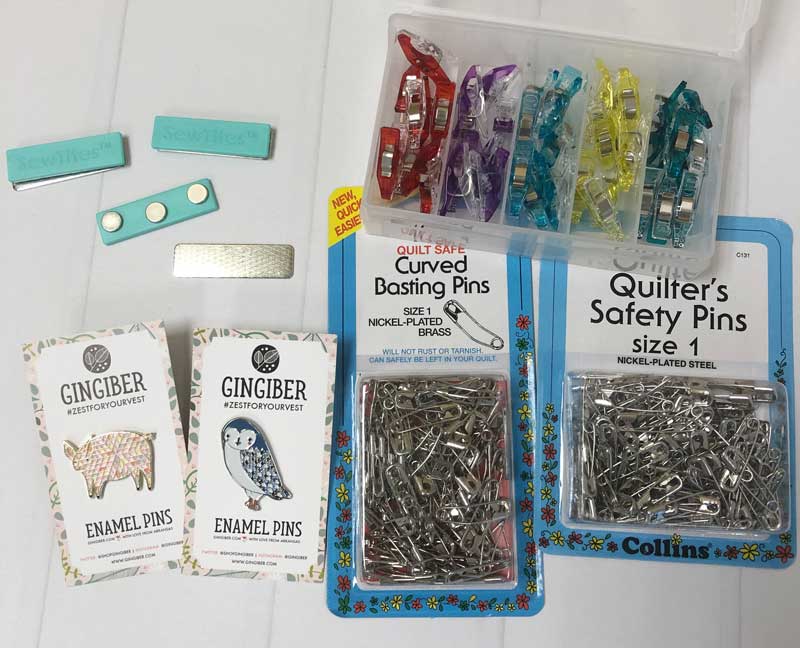
- Clips - e.g., Wonder Clips and binding clips. Clips work especially well when working with heavyweight fabrics or quilted layers. The clips can hold layered sections of sewing projects such as handle connectors to handbags or hold a quilt binding in place while sewing.
- Magnetic pins - e.g., SewTites. Securely hold together leather, cork, and other thick materials with magnetic sewing "pins". Simply align, snap on, and sew. Ideal for English paper piecing, foundation paper piecing, and bagmaking projects.
- Safety pins - primarily used for basting quilts.
- Enamel pins - because they're cute. And popular.
Needles. Let's start with Sewing Machine Needles. The most important thing to remember is to select the type of needle first based on fabric or usage. Then select the correct size based on the weight of the fabric and the size of the thread being used.
Needle type. As with pins, there are three primary types of sewing machine needles used for the majority of home-sewing.
- Universal needles - these have a slightly rounded tip general-purpose needle should be used on wovens and some sturdy knits.
- Jersey needles - these have a medium ballpoint tip designed especially for knit fabrics, allowing the needle to slip between the knit fibers without breaking or damaging them.
- Stretch needles - these are not the same as Jersey needles. While they also have a medium ballpoint tip, they have a special eye and shape designed for extremely stretchy fabrics and elastic.
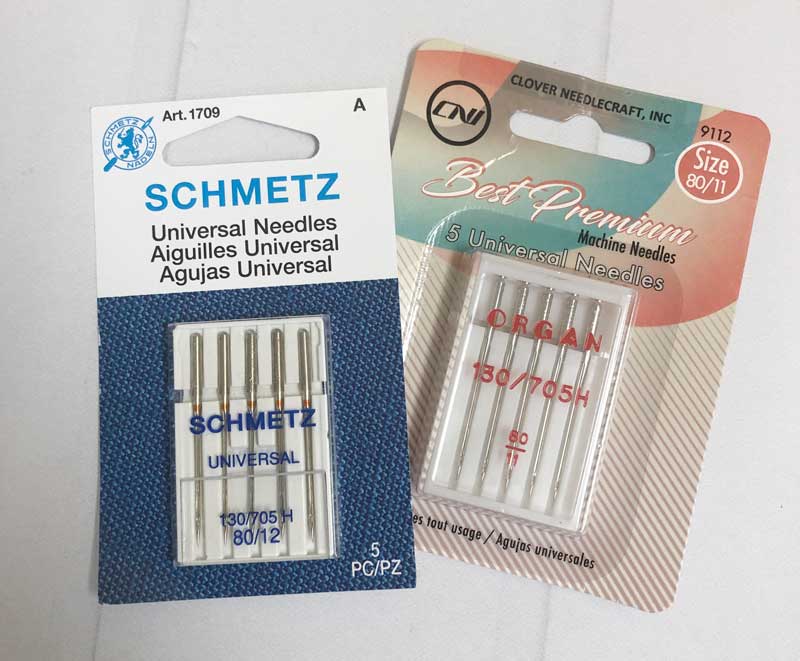
There are also specialty needles for sewing with denim, leather, and suede, and for topstitching, needlepoint and embroidery. There are also special needles for quilting.
Sewing machine needles are classified by size. American needle sizes range from 8 to 19, and European sizes range from 60 to 120. The larger the number, the larger the blade of the needle. Often you'll see both sizing numbers on the needle package, like 80/12 and 90/14.
For most quilters using quilting-weight cotton and 50wt. sewing threads, the correct needle to use is a Universal needle in size 80/12.
Microtex? The Microtex style of need has a thin, sharp accurate point that is ideal for sewing batiks. Designed to be used with micro fibers, polyester, silk, foils, artificial leather, and coated materials such as laminates, this style of needle is also perfect for machine-piecing. (Note that not all sewing machines and threads like Microtex needles... just saying.)
Chrome needles? These needles are relatively new in the market and are desirable because of the increased speed of domestic machines. They have less friction on the thread passing through the eye, penetrate the fabric with less resistance, and create a smoother stitch. They also resist heat, improving durability and performance.
For more information about sewing machine needles - Schmetz Needle Chart.
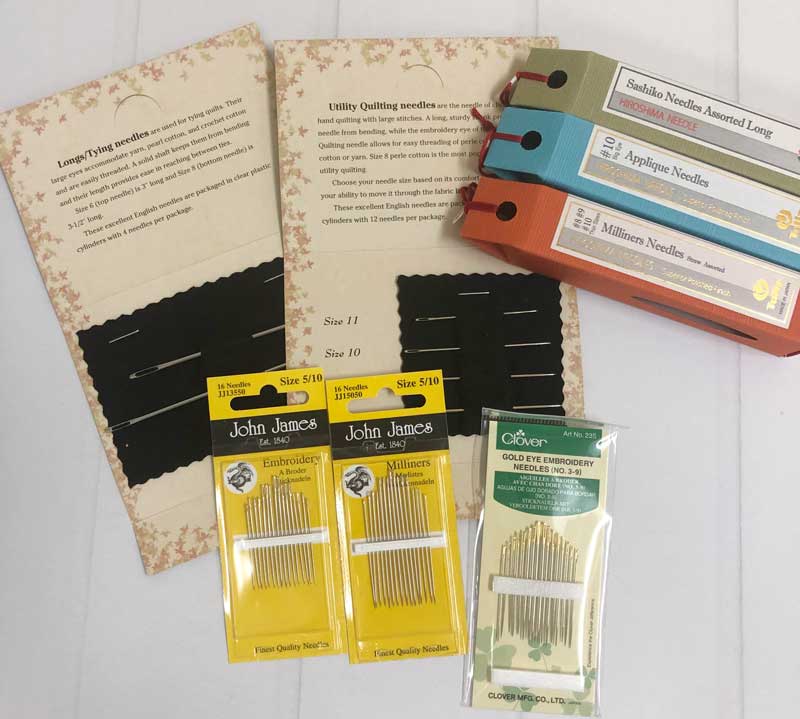
Types of hand-sewing needles.
- Sharps - general purpose sewing needles used by dressmakers and hand-stitchers.
- Milliners and Straw - these needles are long with round eyes and were traditionally used for hat-making. They are also used for pleating and smocking. Today, they are popular as binding needles, and are often used for hand-appliqué.
- Quilting - these are short, fine needles with a round eye. The short length allows the quilter to create quick and even stitches. Sizes range from 5 to 12.
- Betweens - shorter than sharps but longer than quilting needles, these needles have a small rounded eye and are used for making fine stitches on heavy or quilted fabrics. Some manufacturers distinguish Betweens and Quilting needles while others do not.
- Tapestry and Cross Stitch - these needles have a large eye and a blunt round-point designed for needlepoint and counted cross-stitch. Sizes 16-18-20 are suitable for tapestry, while 22-24-26-28 are more commonly used for cross-stitch.
- Embroidery and Crewel - embroidery needles have a long eye to make threading the needle easier when using multiple strands of thread. The most popular sizes are 7 and 9. They are suitable for general sewing and are often used for big-stitch quilting with perle cotton.
- Utility Quilting Needle - the needle of choice for quilters using large stitches. A long, sturdy shank prevents the needle from bending, while the embroidery eye of the needle allows for easy threading of perle cotton, crochet cotton, or yarn.
- Chenille - these large-eye needles have a sharp point and are used for crewel and ribbon embroidery. Sizes range from 13 to 26.
- Darners - these needles can be long or short, have a blunt tip and large eye making them similar to tapestry needles but longer.
Hand-needle sizes. The length and thickness of a needle increases as the size number decreases. E.g., a size 9 needle will be thicker and longer than a size 12 needle.
However, needle sizes are not standardized so a size 10 of one class may be thinner and finer than the size 12 of another type.
Also note that a packet of needles where there are two size numbers, e.g., Straws 3/9, the numbers mean that there is an assortment of needles in the package ranging from size 3 to size 9.
For more information about hand-sewing needles - John James Needles Types & Sizes Guide.
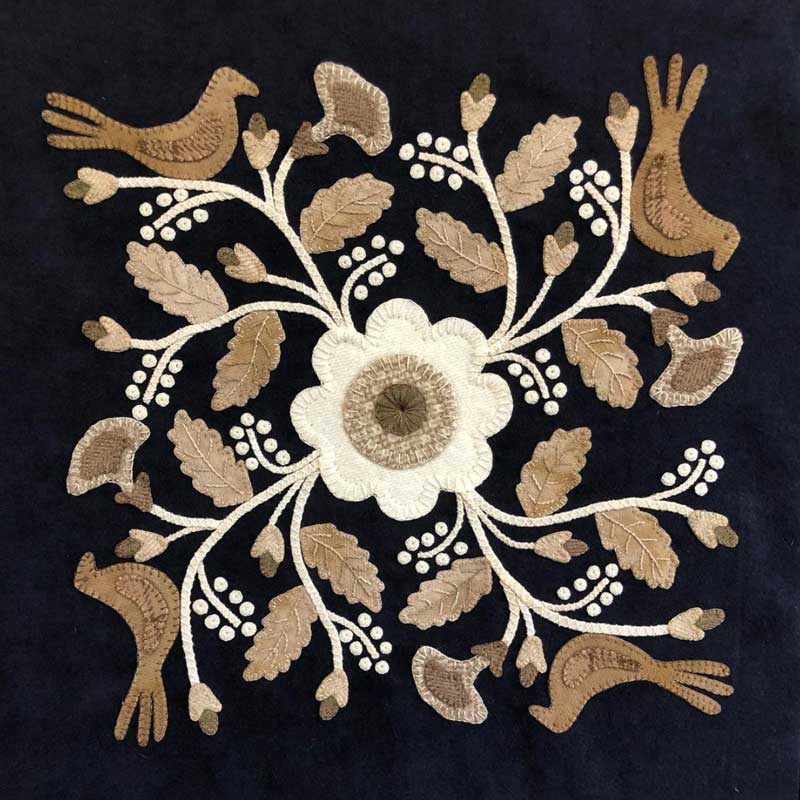
Thimbles? If you're stitching by hand, you'll probably want a thimble or finger protection of some kind. There are metal, plastic and leather thimbles, and there are suede, plastic and needle finger pads.
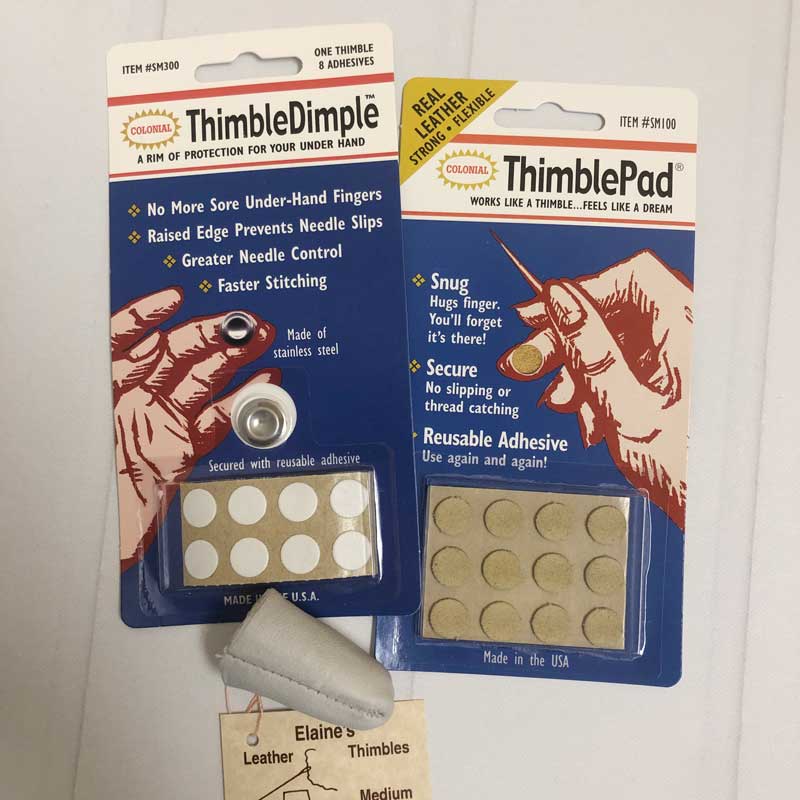
And because you have all these pins and needles... you might need or want a pincushion of some kind. From magnetic to hand-made, wool to the old-fashioned tomato, anything will work.

Chances are you'll have more than one of these - also based on personal preference.
So there you have it - pins and needles.
Wait... a few more things.
- Changing sewing machine needles regularly - just do it. Everybody has a different idea on how often that is but most find that a good guide is every four to five bobbins. It makes a difference.
- Sewing over pins. Bad idea. Some of us will do it anyway but it's still a bad idea.
- Bent or rusty pins. Get rid of them - safely and securely, preferably in a sealed container. Really. Pins aren't that expensive and they can damage your fabrics.
- Pins and needles do get dull. So when they aren't sliding through the fabric easily, it's time to replace them.
Now let's go stitch something!
Maybe some Spell it with Fabric letters?

Comments